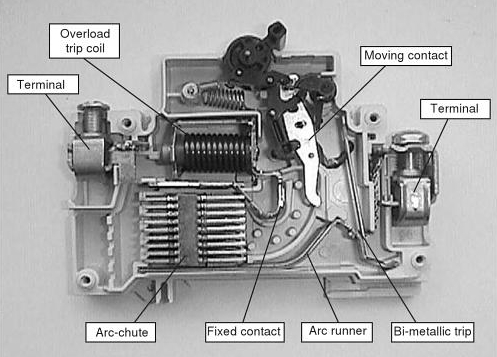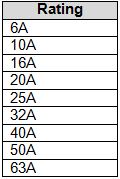Thanks to Manish, another member of the electrical engineering community, for sending us this article about MCBs. Remember you can also send us articles about the topic you want by a mail
MCB stands for Miniature Circuit Breaker. It is a vital circuit breaking component found in today’s modern electrical distribution system. It replaces earlier method of circuit breaking done via melting fuse wire.
A melting fuse wire system is replaceable type of circuit breaking in which the fuse wire melts and permanently breaks the circuit upon an overload current event. Due to this hence it is quite cumbersome to each time replace and fix a new fuse wire.
A miniature circuit breaker on other hand is reusable type of circuit breaking device that is nowadays widely used in homes and offices.
Working Principle
While the main purpose of this article is about selection of MCBs, it is worth summarizing the working principle of MCBs in brief.
MCB is a compact cased device that has an electro-mechanical mechanism inside that provides overload protection.
There are essentially three different mechanisms inside that provide overload protection:
1. Bimetallic Strip: This arrangement is used in situations where a constant overload condition prevails over a long time in the connected circuit thus resulting in heating of bimetallic strip. Due to this the bimetallic strip deflects and causes the attached latch to be released. This causes the attached spring to get released and moving contactor open the circuit.
2. Magnetic Trip Coil: This mechanism comes in force in case of a short circuit event. A short circuit event is associated with a sudden surge of a heavy short circuit current that tends to flow through the circuit. This sudden surge of short circuit current flows through a very sensitive magnetic trip coil inside MCB. This causes a sudden change in magnetic flux and activates the trip coil unit. Due to this, the plunger inside the coil deflects and releases the same latch point and subsequently the same release of spring and opening of the contactor and the circuit.
3. Manual Switching: MCB also has an external ON/OFF switching option to manually break the circuit. This is used in cases of any maintenance / repair activities or for resetting of MCB and power in case of an already occured trip event.
Types of MCBs and their selection
The selection of MCB depends on two important factors like:
- Permissible Overload current level
- Short Circuit current possible in the circuit
Out of the above two, MCBs are classified according to tripping over range of fault current as follows:
Type B:
This type of MCB trips between 3 and 5 times full load current. Type B devices are mainly used in residential applications or light commercial applications where connected loads are primarily lighting fixtures, domestic appliances with mainly resistive elements. The surge current levels in such cases are relatively low.
Type C:
This type of MCB trips between 5 and 10 times full load current. This is used in commercial or industrial type of applications where there could be chances of higher values of short circuit currents in the circuit. The connected loads are mainly inductive in nature (e.g. induction motors) or fluorescent lighting.
Type D:
This type of MCB trips between 10 and 20 times full load current. These MCBs are use in specialty industrial / commercial uses where current inrush can be very high. Examples include transformers or X-ray machines, large winding motors etc.
All the above three types of MCBs provide tripping protection within one tenth of a second.
Selection of a particular type of MCB is a careful choice that needs to be made according to the circuit application type and short circuit protection level required otherwise it might lead to frequent unwanted trippings. Selecting the right MCB should be done in accordance with BS 7671: Requirements for Electrical Installations.
Typical MCB Operating Current Ranges:
The types of MCBs we studied are available in various nominal operating current ratings. Typical operating current ratings are as follows:
MCB Types based on number of Poles
Another practical way of distinguishing MCBs is by way of the number of poles supported by the circuit breaker. Based on that, following types exist:
-
- Single Pole (SP) MCB:
A single pole MCB provides switching and protection only for one single phase of a circuit. - Double Pole (DP) MCB:
A two Pole MCB provides switching and protection both for a phase and the neutral. - Triple Pole (TP) MCB:
A triple / three phase MCB provides switching and protection only to three phases of the circuit and not to the neutral. - TPN (3P+N) MCB:
A TPN MCB, has switching and protection to all three phases of circuit and additionally Neutral is also part of the MCB as a separate pole. However, Neutral pole is without any protection and can only be switched. - 4 Pole (4P) MCB:
A 4 pole MCCB is similar to TPN but additionally it also has protective release for the neutral pole. This MCB should be used in cases where there is possibility of high neutral current flow through the circuit as in cases of an unbalanced circuit.
- Single Pole (SP) MCB:
This was Manish’s tutorial on how to select Miniature Circuit Breakers. What did you thik about it?


Give examples of selecting MCB for different types of loads- lights 10A(incandescent),10A flourescent,10A CFL,10A HPS,LPS,MV,Induction,Halogen,LED etc etc,10A induction motor on DOL,stardelta starting etc
You could definitely see your expertise within the work you write.
The world hopes for even more passionate writers such as
you who aren’t afraid to mention how they believe.
At all times go after your heart.
Take a look at my web-site … stop going bald
Thanks for useful information ”spir Georges” & manish
I think that what you posted was actually very reasonable.
However, what about this? suppose you added a little content?
I am not saying your content isn’t good., however suppose you added a title that makes people desire more?
I mean Selection of Miniature Circuit Breaker
Pretty section of content. I just stumbled upon your web site and
in accession capital to assert that I acquire actually enjoyed account your blog
posts. Anyway I will be subscribing to your augment and even I achievement you access consistently fast.
Take a look at my web blog … Chemist Direct
Hi, I do think this is an excellent site. I stumbledupon it
;) I am going to revisit once again since i have
book marked it. Money and freedom is the
best way to change, may you be rich and continue to help other people.
Feel free to visit my weblog: Chemist Direct Healthcare Products
ABB has made MCB with high breaking capacity like 25 or 50kA unlike 10kA,I remember reading in a website,you can get more information from manufacturer’s publications from ABB,Hager etc
Please how do i know the mcb am to use in any point!
I need to select a D type MCB for connecting a CNC Machine. The machine rated Ampere is 16A. How?
If I have 6W GU10 LED lamps. With inrush current 0.1A at 600 (micro seconds). What is the max load I can use on B10 circuit breaker?
can induction stove work on b class mcb
Since you need to find out from technical data sheet of motor, what is maximum current in starting, if it is more then 10 times of rated current of motor , in that case you will have to select 16A D curve, if it is less then go for C curv of same rating.